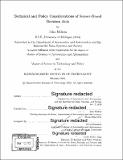Technical and policy considerations of sensor-Based decision aids
Author(s)
Milton, Julia.
Download1199072164-MIT.pdf (9.076Mb)
Other Contributors
Massachusetts Institute of Technology. Department of Aeronautics and Astronautics.
Massachusetts Institute of Technology. Institute for Data, Systems, and Society.
Technology and Policy Program.
Advisor
Leia Stirling.
Terms of use
Metadata
Show full item recordAbstract
The design and operation of complex systems requires methods for decision makers to evaluate the relative merit of alternative options and the implications that choosing one of those options will have. In order for a decision maker to make an informed choice, accurate data and meaningful metrics are essential for understanding and assessing the state of the system. As the data quality and reliability of electromechanical sensor technology improves and the cost and size of commercially available sensors decreases, sensors can be more easily integrated into a wide range of systems to provide quantitative feedback about the state of the system. To effectively interpret and use that data, relevant metrics must be defined and adopted that convey information about processes important to the overall system goal. The types of metrics that are developed, the data sources that they use, and the biases that may be introduced to the system during their formulation all impact the effectiveness of metrics and their ultimate utility in supporting decision-making. This thesis investigates the development and use of sensor-based decision aids by presenting a framework for developing informative metrics using sensor data and integrating those metrics into a system-relevant decision aid. A case study was conducted in collaboration with the Natick Soldier Center and addresses the development of metrics and evaluation methods using data gathered from a body-mounted array of Inertial Measurement Units to provide qualitative knowledge of performance to improve soldier-training exercises. The case study assessed the utility of body-worn IMU sensors to inform metrics of performance and quantitatively differentiate between experts (n = 7) and novices (n 9) in live-fire marksmanship exercises. The results of this study demonstrate that experts and novices have statistically significant differences in technique and performance, as measured by metrics assessing stability, posture, and efficiency. Technical and policy considerations and implications of adapting these performance metrics into marksmanship training and evaluation programs are discussed. These novel methods for assessing performance are of relevance, as the Army is currently undergoing revisions to its marksmanship training program to align the objectives of the program more closely with its operational goals. As the Army revises its training protocols, the outcomes of this study can inform strategy, capabilities, and limitations for the development and implementation of quantitative metrics of performance in marksmanship training.
Description
Thesis: S.M., Massachusetts Institute of Technology, Department of Aeronautics and Astronautics, 2020 Thesis: S.M. in Technology and Policy, Massachusetts Institute of Technology, School of Engineering, Institute for Data, Systems, and Society, Technology and Policy Program,, 2020 Cataloged from PDF of thesis. Includes bibliographical references (pages 103-107).
Date issued
2020Department
Massachusetts Institute of Technology. Department of Aeronautics and Astronautics; Massachusetts Institute of Technology. Institute for Data, Systems, and Society; Technology and Policy ProgramPublisher
Massachusetts Institute of Technology
Keywords
Aeronautics and Astronautics., Institute for Data, Systems, and Society., Technology and Policy Program.